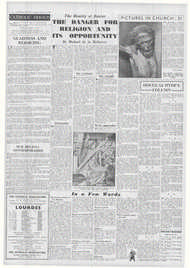Page 7, 22nd March 1951
Page 7

Report an error
Noticed an error on this page?If you've noticed an error in this article please click here to report it.
Tags
Share
Related articles
Abbey Silk Farm Is Blessed
In A Few Words
Tichborne Dole'
New -abbey Shrine
Benedictines Open Press
ABBOT BLESSES SILKWORM EGGS
Ceremony at Farnborough
ALL stages of silk production were included last week for the first time in the annual blessing of silkworm eggs at St. Michael's Abbey,
Farnborough. Firms from various parts of the country assembled to have the symbols of their craft and examples of their work blessed by Dom Wilfrid Upson, 0.S.B., Abbot of Prinknash.
When the abbot had vested at the high altar, the community preceded him to the crypt, followed by the trade procession.
Mulberry planters carried cuttings and bushes cocoon producers had eggs and incubation trays. Then came the silk reelers with cocoons and raw
silk: throwsters with thrown yarn, followed by spinners with spun yarn and, finally, the weavers with their shuttles, loom cards and two lengths of finished material.
SMUGGLED IN
All carried symbols of their ancient craft and presented them to the Abbot for his blessing.
Abbot Upson recalled the various ways by which monks had helped to build up the silk industry in the Past.
There were the two monks who literally smuggled the first silkworm eggs from the East in the time of Justinian; and the monastic weavers of the Abbey of St. Emmerem who made Regensburg so famous for its silk textiles in the 12th century.
Nearer home there was the 15th century monk of Westminster Abbey who. finding the apparatus for the making of silks lying idle in the monastery, asked the King's permissian to bring it into production again.
Again, there was the still more intimate connection between this crypt and the silk industry in that it contained the tomb of Napoleon the Third. Emperor of France and the patron of the great French scientist Louis Pasteur. whose experiments csn siikworms saved the industry when disease threatened its extinction.
It was Napoleon, said the Abbot, who to a great extent financed the building of this scientist's laboratory and when. in spite of its success, Pasteur's system met with official criticism, the Emperor gave him the use of a villa on an estate belonging to his son, the Prince Imperial. which had formerly been a thriving cent'e of sericulture but owing to the disease amongst silkwonms had not been productive for ten years.
RAVENOUS WORMS
there, with the public recognition of the King, Pasteur produced a harvest of cocoons which showed a big profit in his first season.
The Farnborough Abbey Silk Farm reports good progress daring the past year. Already several thousand young trees arc flourishing in the plantation, and a gift of 100 grammes of white mulberry sccd-to be sown this year-should eventually provide enough leaf to feed the many thousands of ravenous worms it is hoped to rear n the future.
Last year's crop et silk was of a very good quality, and some of it is now being set up in one of the monastery looms, to be the first completely home-produced fabric of the abbey.
blog comments powered by Disqus









